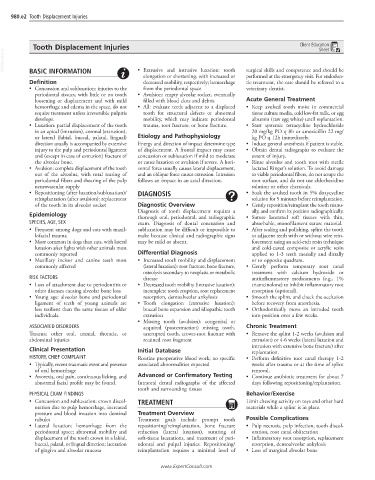Page 1962 - Cote clinical veterinary advisor dogs and cats 4th
P. 1962
980.e2 Tooth Displacement Injuries
Tooth Displacement Injuries Client Education
Sheet
VetBooks.ir
• Extrusive and intrusive luxation: tooth
BASIC INFORMATION
elongation or shortening, with increased or surgical skills and competence and should be
performed at the emergency visit. For endodon-
Definition decreased mobility, respectively; hemorrhage tic treatment, the case should be referred to a
• Concussion and subluxation: injuries to the from the periodontal space veterinary dentist.
periodontal tissues, with little or no tooth • Avulsion: empty alveolar socket, eventually
loosening or displacement and with mild filled with blood clots and debris Acute General Treatment
hemorrhage and edema in the space, do not • All: evaluate teeth adjacent to a displaced • Keep avulsed tooth moist in commercial
require treatment unless irreversible pulpitis tooth for structural defects or abnormal tissue culture media, cold low-fat milk, or egg
develops. mobility, which may indicate periodontal albumin (raw egg white) until replantation.
• Luxation: partial displacement of the tooth trauma, root fracture, or bone fracture. • Start systemic tetracycline hydrochloride
in an apical (intrusion), coronal (extrusion), 20 mg/kg PO q 8h or amoxicillin 22 mg/
or lateral (labial, buccal, palatal, lingual) Etiology and Pathophysiology kg PO q 12h immediately.
direction usually is accompanied by extensive Energy and direction of impact determine type • Induce general anesthesia if patient is stable.
injury to the pulp and periodontal ligament of displacement. A frontal impact may cause • Obtain dental radiographs to evaluate the
and (except in case of extrusion) fracture of concussion or subluxation if mild to moderate extent of injury.
the alveolar bone. or cause luxation or avulsion if severe. A hori- • Rinse alveolus and tooth root with sterile
• Avulsion: complete displacement of the tooth zontal force usually causes lateral displacement, lactated Ringer’s solution. To avoid damage
out of the alveolus, with total tearing of and an oblique force causes extrusion. Intrusion to viable periodontal fibers, do not scrape the
periodontal fibers and shearing of the pulp follows an impact in an axial direction. root surface, and do not use chlorhexidine
neurovascular supply solution or other chemicals.
• Repositioning (after luxation/subluxation)/ DIAGNOSIS • Soak the avulsed tooth in 5% doxycycline
reimplantation (after avulsion): replacement solution for 5 minutes before reimplantation.
of the tooth in its alveolar socket Diagnostic Overview • Gently reposition/reimplant the tooth manu-
Diagnosis of tooth displacement requires a ally, and confirm its position radiographically.
Epidemiology thorough oral, periodontal, and radiographic • Suture lacerated soft tissues with thin,
SPECIES, AGE, SEX exam. Diagnosis of dental concussion and absorbable, monofilament suture material.
• Frequent among dogs and cats with maxil- subluxation may be difficult or impossible to • After scaling and polishing, splint the tooth
lofacial trauma make because clinical and radiographic signs to adjacent teeth with or without wire rein-
• More common in dogs than cats, with lateral may be mild or absent. forcement using an acid-etch resin technique
luxation after fights with other animals most and cold-cured composite or acrylic resin
commonly reported Differential Diagnosis applied to 1-3 teeth mesially and distally
• Maxillary incisor and canine teeth most • Increased tooth mobility and displacement or to opposite quadrant.
commonly affected (lateral luxation): root fracture, bone fracture, • Gently perform temporary root canal
osteolysis secondary to neoplasia or metabolic treatment with calcium hydroxide or
RISK FACTORS disease antiinflammatory medicaments (e.g., 1%
• Loss of attachment due to periodontitis or • Decreased tooth mobility (intrusive luxation): triamcinolone) to inhibit inflammatory root
other diseases causing alveolar bone loss incomplete tooth eruption, root replacement resorption (optional).
• Young age: alveolar bone and periodontal resorption, dentoalveolar ankylosis • Smooth the splint, and check the occlusion
ligament of teeth of young animals are • Tooth elongation (extrusive luxation): before recovery from anesthesia.
less resilient than the same tissues of older buccal bone expansion and idiopathic tooth • Orthodontically move an intruded tooth
individuals. extrusion into position over a few weeks.
• Missing tooth (avulsion): congenital or
ASSOCIATED DISORDERS acquired (postextraction) missing tooth, Chronic Treatment
Trauma: other oral, cranial, thoracic, or unerupted tooth, crown-root fracture with • Remove the splint 1-2 weeks (avulsion and
abdominal injuries retained root fragment extrusion) or 4-6 weeks (lateral luxation and
intrusion with extensive bone fracture) after
Clinical Presentation Initial Database replantation.
HISTORY, CHIEF COMPLAINT Routine preoperative blood work; no specific • Perform definitive root canal therapy 1-2
• Typically, recent traumatic event and presence associated abnormalities expected weeks after trauma or at the time of splint
of oral hemorrhage removal.
• Anorexia, oral pain, continuous licking, and Advanced or Confirmatory Testing • Continue antibiotic treatment for about 7
abnormal facial profile may be found. Intraoral dental radiographs of the affected days following repositioning/replantation.
tooth and surrounding tissues
PHYSICAL EXAM FINDINGS Behavior/Exercise
• Concussion and subluxation: crown discol- TREATMENT Limit chewing activity on toys and other hard
oration due to pulp hemorrhage, increased materials while a splint is in place.
pressure and blood invasion into dentinal Treatment Overview
tubules Treatment goals include prompt tooth Possible Complications
• Lateral luxation: hemorrhage from the repositioning/reimplantation, bone fracture • Pulp necrosis, pulp infection, tooth discol-
periodontal space; abnormal mobility and reduction (lateral luxation), suturing of oration, root canal obliteration
displacement of the tooth crown in a labial, soft-tissue lacerations, and treatment of peri- • Inflammatory root resorption, replacement
buccal, palatal, or lingual direction; laceration odontal and pulpal injuries. Repositioning/ resorption, dentoalveolar ankylosis
of gingiva and alveolar mucosa reimplantation requires a minimal level of • Loss of marginal alveolar bone
www.ExpertConsult.com

